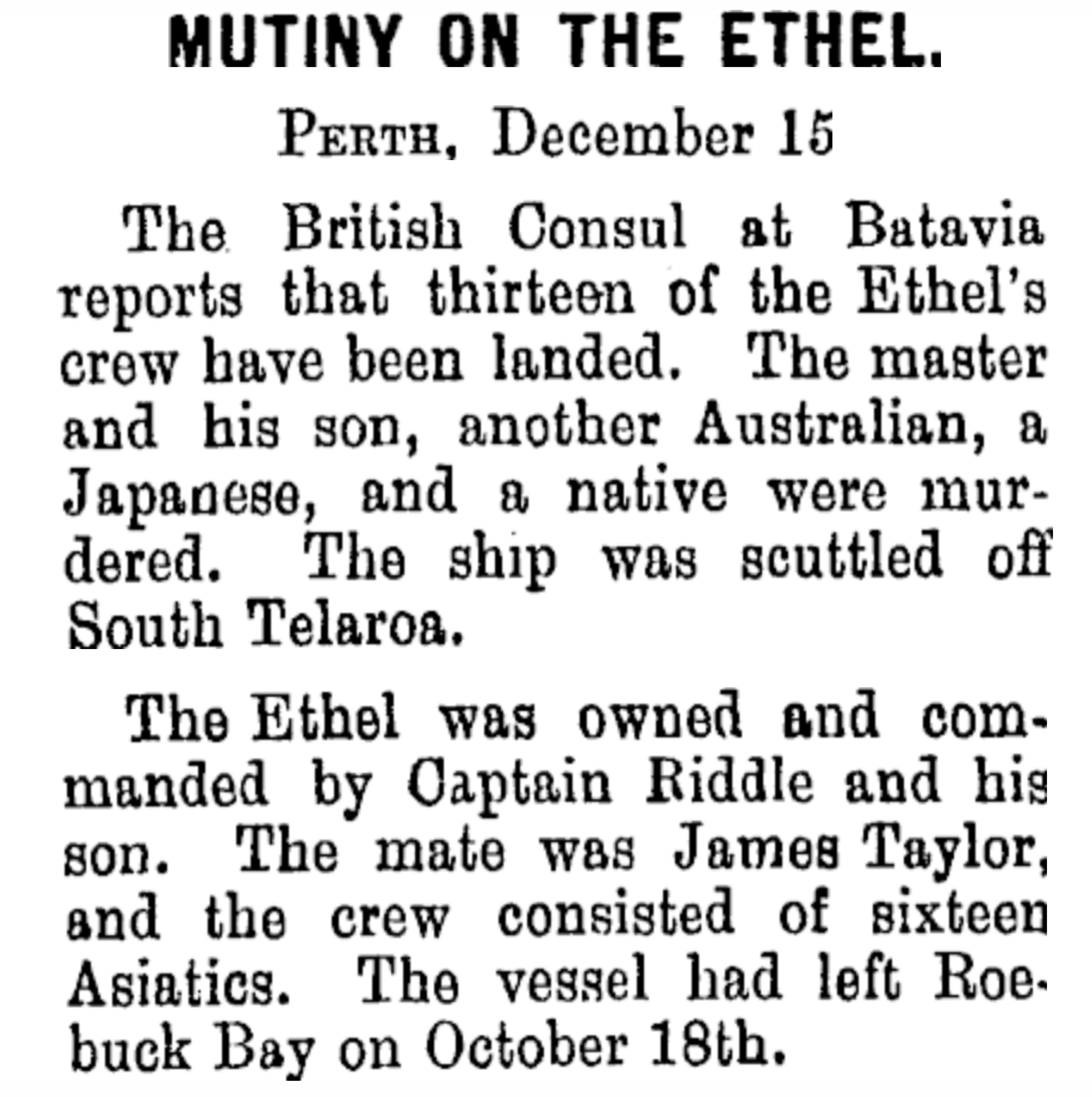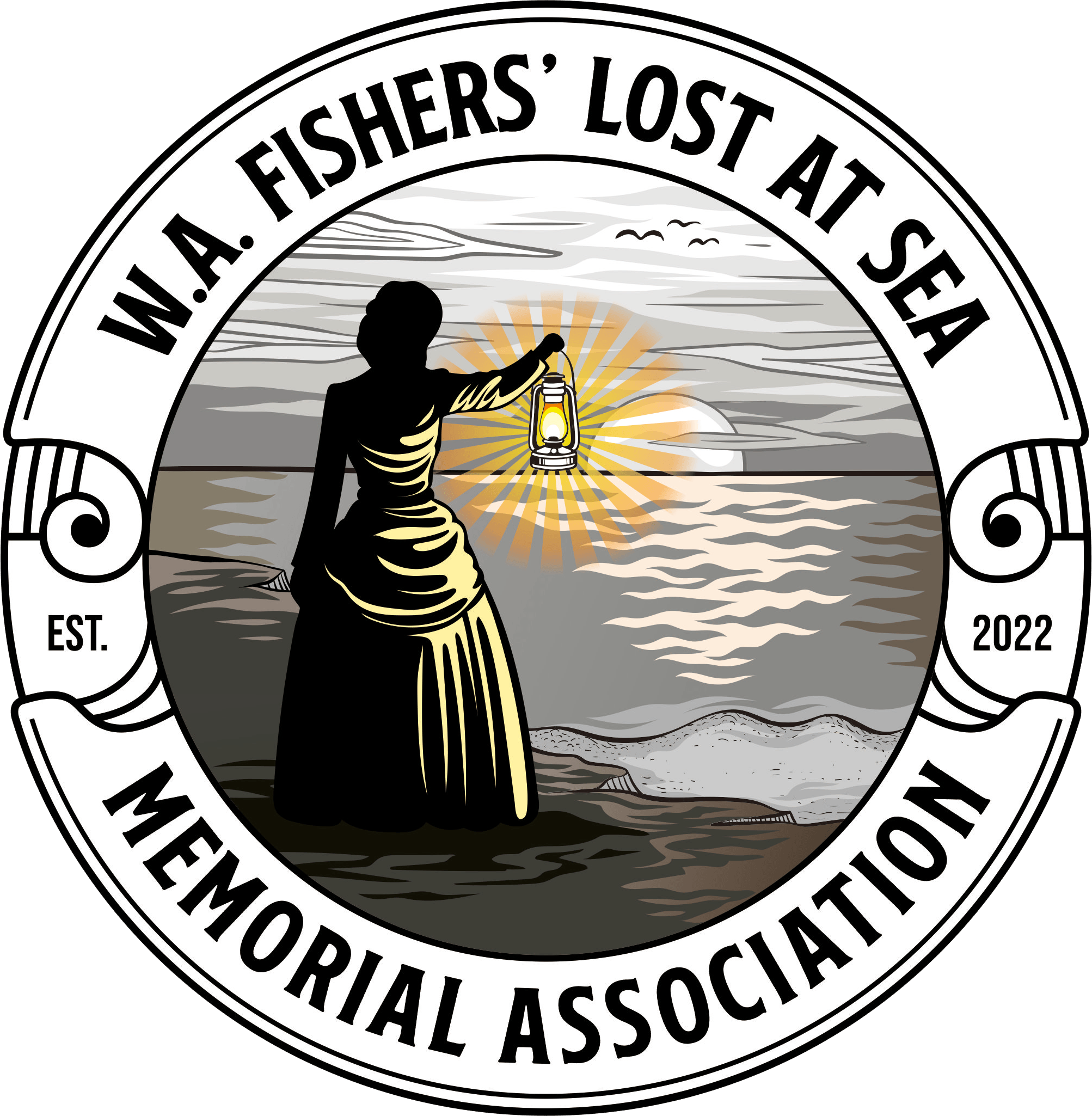Ethel
Vessel Name: Ethel
John Arthur Reddell (Master)
Leslie Jack Reddell (Master’s Son)
James (Jim) Taylor (Carpenter/Mate)
Jimmy (Aboriginal Crew)
Ando (Japanese Crew)
Murdered by Mutiny
19 October 1899

The mutiny was reported in many news outlets
Ethel was the seventh vessel registered in Western Australia in 1870; F1870.She was a two-masted schooner, built in Perth for a group of investors. She weighed 14 tons, was 13.4 metres in length and 3.6 metres across her beam. She drew 1.8 metres of water.
On 7 January 1881, Ethel was moored in Coogoora Creek, at Onslow, for hull cleaning, when a cyclone struck the area. Ethel was driven into the mangroves and damaged.
The Captain, Mr O’Grady, had a son on a nearby vessel, Kate, who was washed away in the surging seas. Ethel was re-floated and repaired and returned to work; one of the lucky few vessels that were repairable after the cyclone.
Captain Arthur John Reddell was a well-known pearl fishery commander who had acquired a fleet of pearling boats. In 1885, he left his position of commodore Captain of the Australasian United Steam Navigation Company (AUSN) in Darwin, and moved his fleet of pearling vessels from the Torres Strait to Broome. The store ship for his fleet was Ethel.
With her luggers and ship’s boats, she worked the pearling grounds successfully for the next few years. Arthur’s crew consisted of chief mate Gibson, his son Leslie “(“Jack”) as second mate, and a crew of mixed-race men.
On 22 April 1887, when most of the West Australian pearling vessels were gathering at Roebuck Bay, the Ninety Mile Beach grounds were struck by a huge cyclone, resulting in a loss of 24 vessels and 550 fishermen.
Arthur was aboard Ethel. He lost two of his ship’s boats and a great deal of deck cargo. Moreover, he lost three luggers with their crew of six men per boat. Ethel was damaged, but fortunately she was repairable.
On 19 October 1899, Ethel rode at anchor Broome with a crew of 18 men. She was heading for the pearling grounds at La Grange (200 miles south of Broome) with mail, contract employees (to replace those ending their contract) and provisions for his crews.
Arthur and Jack were aboard, and ship’s mate and carpenter, John Taylor. The remainder of the crew was made up of five Filipinos, three Malaysians, one Portuguese, two Chinese, one Javanese, one Japanese and two Aboriginals.
One of the Aboriginal men was 18-year-old Jimmy, and his father who was the storeman and clerk. The cook was Pooh Ah Ming, who slept in his galley and prepared all the crew’s meals. The Filipino crew members were Peter Perez (alias Pedro Pailis), Pedro de la Cruz (alias Pedro Delacruz), Maximinio Royaz, Hugo Magdologo (alias Jago Magdalojo), and John Baptiste (alias Dijon Bantista).
At 10pm, with a cloudless sky, a full moon and still seas, Ethel weighed anchor and headed south towards Ninety Mile Beach. Cook Pooh Ah Ming had gone to sleep in the galley at 8pm, before Ethel slipped her moorings. He had to be up early to prepare breakfast.
Pooh Ah Ming was woken at 1.30am, by an unusual noise. At 1.45am, John Baptiste and Hugo Magdologo entered the galley, with Peter Perez and Pedro de la Cruz behind them.
John was carrying a sword, Hugo had two knives, Pedro was holding a tomahawk and Peter had a long knife in his left hand. Hugo threatened Pooh Ah Ming with his knife with intention of killing him, until John spoke to him in Filipino and they drew back. John told Pooh Ah Ming to remain silent, and the men withdrew to the deck.
Pooh Ah Ming watched them through a crevice in the galley. Peter removed his blood-stained shirt and threw it over the side, while Pedro threw away his bloody coat. The men washed blood off themselves.
At 2am, Peter returned to the galley and told Pooh Ah Ming to go to see Pedro at the helm.
Pooh Ah Ming was scared and refused, until Peter threatened him and he feared for his life. He went aft and saw Peter had a revolver. Pedro had a knife in his belt. Hugo was stationed with a double-barrelled gun outside the forecastle where the Malaysian crew members slept. John stood with him, armed with the sword.
Pedro told Pooh Ah Ming to kill a sheep in the morning, and told him he was in charge of the ship. He asked if Pooh Ah Ming wanted to see his former master, but the cook declined in fear and returned to the galley. Hugo followed him, and tried to reassure him, but Pooh Ah Ming saw blood on Hugo’s feet and was still afraid.
At daylight, Hugo went to the galley and told Pooh Ah Ming about the murders they had committed. Hugo had killed Jack, Peter stabbed Captain Reddell and Pedro killed the mate/carpenter. After imparting the news, the Filipinos located beer and whiskey in the stores and commenced drinking.
At 9.30am, Ethel cast anchor not far from the schooner, Alto, for two hours. At 11.30am the crew unshackled Ethel’s anchor, so it didn’t make a noise and alert the Alto, she silently set sail and stole away unnoticed to the north.
Peter sent the crew aft, and brought out the bodies of the dead from the Captain’s cabin.
Jack’s head had been severed from his body with the tomahawk. Likewise, John Taylor had been killed with same weapon. The Captain had been stabbed in his torso. The bodies were lashed together with chain, weighted with an anchor and thrown into the sea. The crew set about cleaning blood from the decks, beds and cabins. It was clear the murders were committed simultaneously, while Jack and John were abed, and Arthur was reading his chart.
Peter told the crew a story, which he said they should repeat if Police asked any questions of them. He said the Captain came to him while he was at the wheel. They argued and the Captain struck Peter. Peter then retaliated. He told them Jack fired a revolver at Peter, and Peter had grabbed the revolver and fired it at Jack, then at Arthur and John. The story did not match the bodies the crew had seen brought up from the cabins.
A week after the murders, Peter shot Jimmy, the Aboriginal lad and threw him overboard. The following afternoon, Pedro sharpened the tomahawk and struck Ando, the Japanese diver. Ando fended the blow with his arm, and ran to the wheel with Ando in pursuit. Ando clung to Peter begging for help, but Peter stepped aside and watched as Pedro struck Ando’s head twice with the tomahawk. Ando’s body was weighted with another anchor and thrown overboard.
Ethel maintained a northerly course for two weeks, during which time the Schooner Nellie, skippered by Charles Edward Gaunt saw her. Weeks later when Nellie docked in Broome, Charles and his crew reported seeing Ethel heading north towards the Malay Peninsula.
Broome authorities communicated with their counterparts in Perth, and cablegrams were sent to ports most likely to have seen Ethel. The last sighting of her was near Timor Laut, on the Tenimber Islands, Indonesia. The crew loaded Ethel’s whale boats and headed to shore. Ethel was scuttled.
Onshore they were met by a school-teacher. Peter told his fabricated story. Pooh Ah Ming saw that Peter was wearing Arthur’s watch and chain, and they had taken his own money (£3 6s), a breast pin and a gold ring.
When the crew were asleep, Pooh ah Ming found the school teacher and told him the true story of Ethel’s mutiny and murders. Dutch soldiers at Uttar Pradesh, Indonesia, were notified, and when the crew took a steamer there, the Filipinos were taken into custody.
Pooh Ah Ming told the Dutch authorities what had happened, and the Australian authorities were advised of the capture. Inspector Farley and P.C. McArthur of the Criminal Investigation Department, Perth, went to Singapore to meet with Dutch authorities who had arrested the Ethel murderers.
They brought the captured men to the Fremantle Prison in the steamship Sultan to appear before the Police Court on 28 April 1900, where they were charged with mutiny, murder and the theft of Ethel.
McArthur went on to solve the Murchison Murder Mystery and other significant murder cases in Western Australia.
The five accused pled not guilty. Evidence was heard by the Perth Supreme Court in May and June 1900. Attorney General R.W. Pennefather and Crown Solicitor R.B. Burnside prosecuted, and Mr Penny, and Mr W.M. Purkiss acted for the defence. Key evidence was provided by the Captain’s boy, and the cook Pooh Ah Ming.
The Executive Council decided on the fate of the five mutinous crew on 11 July 1900. Peter Perez and Pedro de la Cruz were handed a death sentence, and Maximinio Royaz, Hugo Magdologo and John Baptiste were sentenced to life imprisonment.
On 19 July 1900, Pedro de la Cruz and Peter Perez were hanged for the murders of Captain John Reddell, Leslie Reddell and James Taylor.
Hugo Magdalogo died in Fremantle Prison on 16 November 1911.
